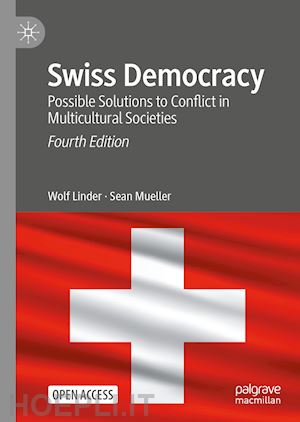

Questo prodotto usufruisce delle SPEDIZIONI GRATIS
selezionando l'opzione Corriere Veloce in fase di ordine.
Pagabile anche con Carta della cultura giovani e del merito, 18App Bonus Cultura e Carta del Docente
1 Introduction
2 Building a Multicultural Society by Political Integration
2.1 Introduction
2.2 The origins of modern Switzerland
2.3 Turning poor odds into good ones, or: factors that made Swiss nation-building a success
2.3.1 Economy
2.3.2 Pressure from the outside
2.3.3 Democracy and social values
2.3.4 Combining democracy with federalism
2.4 Religious and ethnic minorities: from coexistence to pluralism
2.4.1 Political Catholicism: From segmentation to integration
2.4.2 Multilingualism: Understandings and misunderstandings
2.4.3 Jura – The exception to integration
2.5 The challenges of socio-economic inequality
2.5.1 A working class without a homeland
2.5.2 From class struggle to economic partnership
2.6 Proportional representation: The universal key to power-sharing
2.7 The limits of Swiss pluralism – New challenges for integration
2.8 Conclusion
3 Federalism
3.1 Institutions
3.1.1 The Swiss interpretation of federalism
3.1.2 The division of powers between the federation and the cantons
3.1.3 Non-centralisation – Not decentralisation
3.1.4 Relations between the federation and the cantons
3.2 Federal elements in the decision-making process
3.2.1 Bicameralism
3.2.2 The people’s and the cantons’ vote
3.2.3 Local governments: The corner stone of the Swiss ‘bottom-up’ state
3.2.4 Citizens’ self-administration
3.3 Federalism at work
3.3.1 Cooperative federalism: How federal tasks are implemented by cantons and communes
3.3.2 From federal deadlock arise cantonal experiments: Energy policy
3.3.3 Coping with inequality: The example of Swiss primary schools3.3.4 Swiss federalism: solidarity is more important than competition
3.3.5 Dealing with separatism: The arduous birth of a new canton
3.4 The limits of Swiss federalism
3.4.1 Limits of implementation: Why some foreigners can buy real estate in Switzerland but others cannot
3.4.2 The weakness of federal authorities, or how a canton can deny human rights to its citizens
3.5 Challenges3.5.1 Federalism vs. democracy: Why one citizen from Uri outweighs 35 citizens from Zurich, or to what extent is federalism compatible with democracy?
3.5.2 Urban regions – The forgotten dimension of Swiss federalism
3.5.3 The external challenge: Federalism in a period of globalisation3.5.4 The internal challenge, or: Why do the Swiss want to preserve federalism
References
4 Direct Democracy
4.1 Introduction: The vote to abolish the Swiss army
4.2 Institutions, historical development and meanings of direct democracy
4.2.1 Obligatory and optional referenda4.2.2 The popular initiative
4.2.3 Direct and semi-direct democracy: Historical origins and development
4.3 A closer look at the referendum and the initiative
4.3.1 The issues
4.3.2 Direct democracy’s role in political agenda-setting
4.3.3 The use of referenda and initiatives
4.3.4 ‘Braking’ referenda and ‘innovating’ initiatives – Two different devices of direct democracy
4.3.4.1 The braking effect of the referendum
4.3.4.2 The innovating effect of the popular initiative
4.4 Participation in direct democracy
4.4.1 The deciding majority, or who are the people?
4.4.2 Regular voters, occasional participants and abstentionists
4.5 The people between knowledge, trust and propaganda
4.5.1 Example of a vote: Should there be tougher restrictions on refugees seeking asylum in Switzerland?
4.5.2 Shaping opinions in a voting campaign: The actors
4.5.3 Are voters capable to decide on high policy? Theory and Swiss experience
4.5.4 The role of political parties and their campaign
4.5.5 Can money buy votes?
4.6 Conclusions
4.6.1 Semi-direct democracy – An exceptional system
4.6.2 Direct democracy between integration and polarisation
4.6.3 Digitalisation: opportunity, risk – or both?
4.6.4 The political culture of direct democracy – Particularities and limits
5 Consensus Democracy: The Swiss System of Power-Sharing
5.1 The development of Swiss consensus democracy5.1.1 The impact of the referendum on the composition of the government
5.1.2 Impacts on the legislative process
5.2 The system of power-sharing: Actors and the political process
5.2.1 Actors and their functions
5.2.2 The policy cycle
5.3 The features of power-sharing
5.3.1 The main characteristics of political compromise: No single winner takes all, everybody wins something
5.3.2 The technique of political compromise: Compensations that transform conflict from zero-sum into positive-sum games
5.3.3 Cooperation, trust and the deliberative learning processes5.3.4 Political elitism and its limits
5.4 The critics of Swiss consensus democracy
5.4.1 The referendum as an instrument of vested interests5.4.2 Inequalities of influence
5.4.3 Lack of innovation?
5.5 Consensus democracy under stress
5.5.1 The ‘Konkordanz’ crisis of 2008
5.5.2 Power-sharing in a polarised parliament
5.5.3 The pressure of globalisation
5.6 Conclusions
5.6.1 Swiss Democracy – An exceptional system
5.6.2 Who has more influence: The British or the Swiss voter? – or: The trade-off between elections and direct participation
5.6.3 Consensus democracy – Its past and its future
<










Il sito utilizza cookie ed altri strumenti di tracciamento che raccolgono informazioni dal dispositivo dell’utente. Oltre ai cookie tecnici ed analitici aggregati, strettamente necessari per il funzionamento di questo sito web, previo consenso dell’utente possono essere installati cookie di profilazione e marketing e cookie dei social media. Cliccando su “Accetto tutti i cookie” saranno attivate tutte le categorie di cookie. Per accettare solo deterninate categorie di cookie, cliccare invece su “Impostazioni cookie”. Chiudendo il banner o continuando a navigare saranno installati solo cookie tecnici. Per maggiori dettagli, consultare la Cookie Policy.